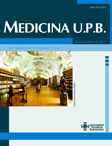Hiperqueratosis epidermolítica
Contenido principal del artículo
Resumen
Existe un grupo de desórdenes hereditarios de la cornificación, caracterizado por una excesiva acumulación de escamas en la piel, que varía desde leve y asintomático hasta amenazar la vida. El término ictiosis es derivado de la raíz griega “icti” que significa pescado. La Hiperqueratosis Epidermolítica (HE), también conocida como eritrodermia ictiosiforme congénita, es un desorden autosómico dominante de la cornificación, con una prevalencia de 1:100.000-300.000. Esta patología se evidencia al nacer o al poco tiempo por la presencia de ampollas y de eritrodermia. Existe un gran número de tipos de ictiosis, de los cuales, la mayoría son extremadamente raros. Entre los cuatro más comunes se encuentran: Ictiosis vulgar, Ictiosis ligada al gen X, Ictiosis lamelar, hiperqueratosis epidermolítica. Se presenta el caso de un paciente de 13 años, con diagnóstico clínico de hiperqueratosis epidermolítica que es llevado a consulta médica por compromiso severo de la piel.
Referencias
Ammirati C, Bayliss S. The major inherited disorders of cornification, new advances and pathogenesis. Pediatric Dermatology. 1998, vol 16, p. 497-506.
Wolff K, Allen R. Fitzpatrick Dermatology Atlas. The Color Atlas and Synopsis of Clinical Dermatology. McGraw Hill. Séptima edición, 2008 , p. 401-423.
Pulkkinen L, Christiano A, Knowlton R, Uitto J. Epidermolytic Hyperkeratosis (Bullous Congenital Ichthyosiform Erythroderma). The journal of clinical investigation. 1993, vol 91, p. 357-361.
Virtanen M, gedde-dahl T, mork N, leigh I, Bowden P, vahlquist A. Phenotypic/Genotypic Correlations in Patients with Epidermolytic Hyperkeratosis and the Effects of Retinoid Therapy on Keratin Expression.[abstract]. Acta Derm Venereol. 2001, p. 163-170.
Lacz N, Schwartz R, Kihiczak G. Epidermolytic hyperkeratosis: a keratin 1 or 10 mutational event. Int J Dermatol. 2005, vol 44, p. 1-6.
Ross R, DiGiovanna J, Capaldi L, Argenyi Z. Histopathologic Characterization of Epidermolytic Hyperkeratosis: A Systematic Review of Histology from the National Registry for Ichthyosis and Related Skin Disorders. J Am Acad Dermatology. 2008, p. 86-90.
Tsubota A, Akiyama M, Sakai K, Goto M, Nomura Y, Ando S, Abe M. Keratin 1 gene mutation detected in epidermal nevus with epidermolytic hyperkeratosis. J Invest Dermatology. 2007, p. 1371-1374.
Bergman R, Ziad K, Sprecher E. A Unique Pattern of Dyskeratosis Characterizes Epidermolytic Hyperkeratosis and Epidermolytic Palmoplantar Keratoderma. J Am Acad Dermatopathology [abstract] 2008. Vol 30.
Rendon A. Pautas Diagnósticas y Terapéuticas. 2001. p 46-49.
Cakmak A, Baba F, Cakmak S, Shermatov K. Treatment Of Congenital Ichthyosis With Acitretin. The internet Journal of Pediatrics and Neonatology. 2008, vol 8.
Pichardo R, Morantes J. Desórdenes de la cornificación. Derm. Venezolana. 1993. vol 31. P. 32- 39.


